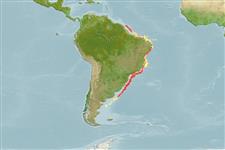Environment: milieu / climate zone / depth range / distribution range
Οικολογία
Θαλασσινό(ά) βενθικό(ς); εύρος βάθους 115 - 210 m (Ref. 47377), usually 152 - 159 m (Ref. 26282). Tropical
Southwestern Atlantic: known from Brazil (Ref. 53036), Uruguay (Ref. 54736) and Argentina (Ref. 2806).
Μέγεθος / Βάρος / Age
Maturity: Lm ? range ? - ? cm
Max length : 10.3 cm TL αρσενικό/απροσδιόριστο; (Ref. 47377)
The young are pelagic, near the coast (Ref. 47377).
Life cycle and mating behavior
Maturities | Αναπαραγωγή | Spawnings | Egg(s) | Fecundities | Προνύμφες
Matsunuma, M., A. Ujihara and H. Endo, 2023. Two new species of Aulotrachichthys (Beryciformes: Trachichthyidae) from the northwestern Pacific. Ichthyol. Res. 71(1):56-82. (Ref. 130070)
IUCN Red List Status (Ref. 130435)
Threat to humans
Harmless
Human uses
αλιεία: χωρίς ενδιαφέρον
Εργαλεία
Special reports
Download XML
Διαδικτυακές πηγές
Estimates based on models
Preferred temperature (Ref.
123201): 11.5 - 23.6, mean 18 °C (based on 38 cells).
Phylogenetic diversity index (Ref.
82804): PD
50 = 0.5039 [Uniqueness, from 0.5 = low to 2.0 = high].
Bayesian length-weight: a=0.01096 (0.00451 - 0.02668), b=3.03 (2.82 - 3.24), in cm total length, based on LWR estimates for this species & (Sub)family-body (Ref.
93245).
Τροφικό Επίπεδο (Ref.
69278): 4.1 ±0.6 se; based on size and trophs of closest relatives
Ελαστικότητα (Ref.
120179): Μεσαίο(α), ελάχιστος χρόνος για διπλασιασμό πληθυσμού 1,4 - 4,4 έτη (Preliminary K or Fecundity.).
Fishing Vulnerability (Ref.
59153): Low vulnerability (10 of 100).
